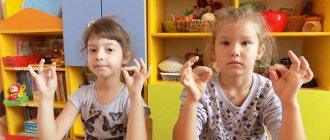Caring for health in kindergarten
Preschool educational institutions provide a whole range of measures to preserve and strengthen children's health. This complex is called “health-saving technologies”. Their meaning is to unite doctors, teachers, parents and children with a common goal. This is a system of health-improving, preventive and corrective measures carried out in the process of preschool education.
What kind of activities are held in kindergarten? This includes group work, warm-ups and gymnastics, sports and outdoor games, relaxation sessions and dynamic breaks for preschoolers. In addition, finger and breathing exercises, as well as eye exercises.
Who is dynamic gymnastics for?
Now let’s talk about which children primarily need these classes. Indications and contraindications can be agreed with the pediatrician. But there is a special conversation about children - “Caesareans”. The fact is that in the case of a planned cesarean section, the child is removed from the uterus (“born”) 3-5 minutes from the start of the operation. As a result, such a child is deprived of the adaptation period with all its phases, as happens when passing through the natural birth canal for several hours. According to the laws of adaptation theory, the body has a need for physiological stress as a necessary condition for development. Let us recall the definition of the founder of the theory of stress, physiologist Hans Selye: “Stress is a nonspecific response of the body to any demand presented to it.” As a result of such a response, the body realizes its need to carry out an adaptive function and restore a normal state. At the same time, one of the basic instincts of the body is activated and strengthened - the survival instinct. And this begins with the situation of the birth process with its sudden onset, many hours of increased muscle tension, increasing oxygen starvation during contractions and unpredictable changes in the environment with the need for further survival in conditions of various sensory loads. The duration of the process allows the child to adapt to changing conditions, developing adaptive reactions. In the case of a caesarean section, the child goes “from the ship to the ball”, without having time to prepare, having lost some phases of the adaptation process.
In perinatal psychology, it is believed that intranatal (birth) experience is important for the further development of a person, the formation of such qualities as determination, endurance, patience in achieving a goal, and is reflected in the ability to demonstrate these qualities in future adult life. It can be assumed that, being deprived of the “incoming” experience of overcoming stress, a person to some extent (taking into account the perinatal memory of the body) may be characterized by a decrease in volitional sensory skills in the future. This is when there is a goal, but the path to achieving it has not been mastered. At the moment of its birth, the body did not know its experience. This is, of course, reparable. This is where dynamic gymnastics can come to the rescue, to teach the child’s body (and therefore the psyche) to withstand, endure increased, threshold loads, and develop adaptive stability. The child grows more energetic, mobile, active, and practically does not get sick. He has excellent coordination, quick reactions, good appetite and good sleep.
What are dynamic pauses for preschoolers?
These are small, active activities throughout the day that satisfy every child's natural need for movement. It is vital for a child of this age to run, jump, hop on one leg, copy those around him, and imitate birds and animals. Planned sports activities and walks in the fresh air are usually not enough to satisfy this need. Modern children are often busy with useful, but sedentary activities: drawing and modeling, learning the basics of counting and writing. Such activities must be alternated with active ones.
What meaning do dynamic pauses carry for preschoolers? They entertain children, create an atmosphere conducive to learning, bring elements of relaxation, relieve nervous tension from overload, unite children with each other, promote interaction, educate and instill communication skills, teach new skills and knowledge, develop attention, speech, thinking and memory. They are also able to unobtrusively correct emotional problems in a child’s behavior, prevent psychological disorders, and promote health.
Why does a child under one year need dynamic gymnastics?
By doing this type of developmental exercise with a child, we simultaneously achieve several goals.
Firstly, it is important for the physical development of the baby. Dynamic gymnastics is a tool for correcting a child’s muscle tone. It is known that after birth, a child remains for several months in a position that we call “intrauterine” - with bent arms and legs. This occurs due to increased tone of the flexor muscles, and this tone is unevenly increased in different muscle groups. Look closely at your baby while he sleeps and you will see that one arm is bent more than the other; the same with the legs. This occurs due to the uncoordinated functioning of different areas of the brain at this stage of life. These are like “flashes”: stimulation of any area of the brain leads to contraction of the corresponding muscle of the body. Such unexpected muscle twitches can frighten even the child himself, for example during sleep. The result is an increased level of arousal caused by excess stimulation coming from one's own body. To help the child’s body harmonize and streamline the processes of excitation and inhibition in the nervous and, as a result, in the muscular system, massage and dynamic gymnastics are used. It’s good if a person whom the child trusts very much works with the child - first of all, this is, of course, his mother. The mother “sculpts” the child’s body with her own hands, marking its boundaries, while influencing tactile and muscle-joint sensitivity. As a result, excess muscle tone is removed. In addition, these exercises activate intestinal motility, strengthen the cardiovascular and immune systems, and adapt the body to stress, and therefore to the stressful effects of environmental changes.
Secondly, this is, of course, another way for a child to communicate with his mother - the opportunity to see her smile and eyes and his reflection in them, hear her voice, feel her hands. The child recognizes himself through the eyes of his mother. It's like a mirror for him. It is no coincidence that psychotherapy uses mirror and smile treatment: the patient looks in the mirror, smiles at himself, recognizes himself. The eyes give the child a feeling of confidence that he is being held and cared for. A child in the first months of life should receive a large portion of auditory, visual, and tactile sensitivity from the mother. As a result, basic trust in the World appears, a desire and ability to interact with it is formed, which will respond favorably in the adult life of a growing person. Thus, performing dynamic gymnastics contributes to the mental development of the child and the formation of harmonious mother-child relationships.
How are they carried out?
What exactly are dynamic pauses for preschoolers? These are outdoor games, round dances, exercises to control posture, physical education minutes and finger games, as well as massage of the hands and face, exercises to rhythmic music and special classes in valeology. Such classes can be started in the morning. For example, line the children up in a circle, inviting everyone to extend their hands and say hello to their neighbors. You can pair children up and invite them to stand elbow to elbow, shoulder to shoulder, back to back. Such breaks not only entertain children, lift their spirits and allow them to finally wake up in the morning, but also help establish a friendly atmosphere in the team.
At this age, the correct development of sound pronunciation is very important, so classes must include words. Dynamic pauses for preschoolers aged 6-7 years must certainly include proverbs and sayings on various topics, and short poetic texts. You can invite the children to recite funny poems about animals together with the teacher, and you can accompany this with a variety of movements.
Basic rules of dynamic gymnastics
Classes are conducted at an air temperature of 22-25°C, indoors or outdoors. If you have already begun to harden your child, then the air temperature in the room may be lower. It is important to touch your baby with warm, soft hands - confidently and gently. Before this, you can soften your hands with a scrub, which will increase their sensitivity. The baby's body is not lubricated with cream.
For classes, use the child’s waking hours, when he is most inclined to contact, but not earlier than an hour after eating. For reference: periods of wakefulness increase sharply after 1.5 months of life during the transition from the normal autistic phase of the infant’s development (when he clearly preferred sleep to wakefulness, which protected him from excessive influence of the external environment) to the beginning of the formation of subject-object relationships - interaction with others. From this age, you can expand the set of developmental exercises. A similar complex should be performed daily or several times a day, each time starting as a warm-up with traditional massage techniques of stroking, rubbing, kneading, passive exercises for the arms and legs, and then moving on to dynamic effects. Examples of exercises included in the complex of dynamic gymnastics are rocking the child back and forth while holding hands, rotating the child by the arms or legs around a vertical axis, and others.
Training fine motor skills
The degree of development of fine manual motor skills is one of the most important indicators of a child’s overall development. There are entire methods for developing and maintaining health through finger games and hand massage. Already at the age of two, children can be taught self-massage techniques. There are a lot of funny and instructive poems dedicated to children's palms and each finger individually, which they memorize with pleasure and are accompanied by fun exercises.
You need to massage your fingers alternately from the big to the little finger. Each finger is stroked from tip to base, while reciting rhymed riddles and nursery rhymes. The palms can be massaged with balls of different sizes, a hexagonal pencil or rosary - these are also dynamic pauses for preschoolers. The older group (starting from 5 years old) is already able to understand what self-massage of the face is for the prevention of influenza and ARVI. Children are taught to look for special points on the face and neck, by pressing and massaging which they can prevent the development of a cold.
Rules are important
So, whether or not to choose dynamic gymnastics for your kids is the will of the parents. But if they have already made such a choice, it is necessary to organize the process in such a way that the child receives only positive emotions and practical benefits from it. To do this, it is important to eliminate the risk of injury and take into account the age and condition of the baby. If he is not in the mood or is sick, he should not exercise.
What do you need to know to do everything right?
- Consider the physical condition of the baby. The lesson should take place either 1 hour before meals or an hour after. The baby should be in an active state (not just woke up, not going to sleep). By the way, after a month and a half, periods of wakefulness begin to increase, which helps to increase the arsenal of exercises performed.
- To achieve the hardening effect, the baby is completely undressed, and the room temperature is maintained at around 22 degrees. To do this, you can either open the window or ventilate the room before gymnastics.
- An adult's hands should be soft and warm. Therefore, at a minimum, they need to be thoroughly rubbed.
- The surface on which they will work with the baby must be flat and hard (this can be an ordinary table), it must be covered with a flannel diaper or terry towel.
- Children under one year old get tired very quickly from any physical or psychological stress, so do not exercise for too long: 15 minutes a day is more than enough.
- Increase the load gradually. Remember that initially this is stress for the baby, do not make it excessive. A couple of simple exercises will suffice to get you started. It would be wrong, for example, to start throwing a baby over an adult’s head or thigh from the very first day. Gradually increase the number to 2 exercises for each muscle group. The amplitude of movements, as well as their intensity, also needs to be increased gradually. That is why it is better that the classes are conducted not by the parents themselves, but by experienced specialists.
- Each exercise is repeated at least 3 times. It is recommended to alternate different types of load.
- If during classes a child shows a protest against increasing the load, which can be expressed in dissatisfaction, whims, crying, muscle tension, it is worth stopping for a while at the achieved level without raising the bar, and sometimes it is useful to even “roll back” a little. Remember that each child develops individually and masters various exercises as well. Therefore, when building a program for such classes, you need to focus primarily on the condition of the baby himself, on his progress, and not on any standards. Activities should bring joy to the child, and not deprive them of strength.
Other games and exercises
A set of physical exercises used during dynamic pauses is aimed at correcting posture, preventing flat feet, strengthening muscles and developing coordination. Exercises are carried out simultaneously with reading poetry, cheerful music, counting or ditties. Dynamic breaks for preschoolers to music also have a very positive effect on children who move, dance and jump with pleasure, and tap the rhythm on a tambourine or drum with their fingers on command.
To develop coordination of movements, they also use walking forward with their backs, throwing a ball, and playing with a skipping rope. There are many games where children must portray certain characters or guess who or what they are talking about based on characteristic movements. During school hours, sitting children can be asked to do a “dry wash” - rub their hands, “wash” their face, comb their hair, massage their eyebrows, stroke the wings of their nose with their index fingers, rub their lips and earlobes.
Games to develop coordination
Bell
◈ Are you busy or have nothing to do with your child?
◈ Hang a rope over the doorway and tie a bell to it. The child must crawl under it back and forth without touching the bell. If the bell rings, it means the child has lost.
◈ You can also use two ropes with two bells, tying their ends to the backs of the chairs. The distance between the ropes should be at least 50 cm. Let the child try to climb between them, trying to prevent the bells from ringing.
Get it
◈ Tie a bell, a ball or any other toy to the doorway. The baby must jump and get the object. Give him a task - touch the toy 5 times. If it works, it means you won.
Hit it
The game teaches you how to hit a target from a distance.
Necessary equipment: basin, small ball or fir cones, acorns.
◈ How to play: place the basin on the floor. Invite your child to throw a ball there from a distance of 20–30 cm. If you hit it, it means you’re clever and won. You can throw balls, cones, and acorns.
◈ Reinforce: during a walk, draw a circle on the asphalt - the child must throw a small object into it, for example, a ball or a pebble. You can arrange a competition - whoever throws the most objects into the circle is the winner!
Snowballs
The game teaches you to hit a target from a distance and a moving target
◈ How we play: in winter there is a lot of entertainment on the street. Playing in the snow is a healthy and fun activity for kids. Whoever has the most hits on the target - for example, a hill or a tree trunk - gets a prize.
◈ Attach: snowballs can be thrown into a bucket or box.
Obstacle course
◈ In rainy weather, when you can’t walk outside, play at home: set up an obstacle course. For example, a child must jump from a high chair, walk along a “rope” (a rope lying on the floor), crawl under the rope, jump on one leg to the high chair where there is a flag, bell, ribbon, etc., and pick up this object. If a child completes the entire obstacle course without making a mistake, give him a prize! He is the winner!
◈ The obstacle course can be changed and expanded: throw the ball into the basket, roll the ball along the path, etc.
"Girl on the Ball"
◈ Many people have large balls at home, on which it is useful to do exercises while lying on your back or stomach; roll, pushing off the floor with your hands; sit down and lie down. Come up with interesting and useful exercises together with your child. Invite him to transform into a circus performer - a flexible gymnast. And you will see what miracles your baby is capable of.
Fisherman
◈ Remember that game in which you have to hook a fish with a fishing rod with a magnet? The main thing is that you have a magnet on a string, and you can easily make fish yourself (for example, from corks and nails). The one who catches the most fish is the luckiest fisherman.
Bouncers
◈ This game needs to be played by three people. Two participants stand at a distance from each other, the third is in the middle. The players need to throw the ball to hit the participant standing in the center. And his task is to dodge to the side. This game can be played on a walk, on a picnic, on the beach.
Ball, ball, jumps deftly
◈ How many fun exercises you can do with a ball! Throw and catch it; throw into a hanging basket; throw the ball, clap your hands and catch it; run and fight him off as he goes; dribble the ball to the drawn line; hit it and count the number of hits, etc. Such games perfectly develop dexterity and coordination of movements.
How neurogymnastics exercises affect the brain
Thanks to kinesiological training, positive changes occur in the child’s body, for example, the child becomes strong, plastic, resilient, and flexible. Neurogymnastics for children, a set of exercises aimed at combating problems in the development of intelligence, also allows you to identify the child’s hidden abilities.
Important! The dynamic process is needed if you want to improve the quality and content of your life and enjoy the movements.
Children need to do stretches while lying down, sitting, or standing. The child himself chooses characters that are interesting to him. For example, you can depict any animal, flower, bird, etc.
Exercises that have a positive effect on the brain
Classification of exercises
Here are a few exercises that have a beneficial effect on the human brain:
- "Brain Buttons"
Note! This physical education will help you to have a positive attitude towards performing certain actions. Charging alerts the vestibular apparatus.
To perform the action, you need to draw indentations between the first and second ribs with one hand. The other hand should be placed on the navel area. This exercise optimizes brain activity.
- "Hooks"
Such movements will help you get involved in any process and fully perceive the information. The influence of kinesiological training helps to activate the functioning of the intellect. The steps need to be repeated up to 10 times. To begin with, you can try up to 5 times.
Outdoor games for younger kindergarten groups
Physical activities can be performed standing, sitting, lying down. The main condition is to cross your ankles. Then you need to stretch your arms forward, crossing your palms towards each other. Your hands should be kept at such a distance that your elbows are lowered to the bottom.
- Exercises for rest
Anyone who does gymnastics must rest regularly.
Note! A child’s body is a fragile mechanism, so children should not be subjected to heavy loads. Music and dance are suitable for relaxation. Charging occurs slowly three to five times.
What is neurogymnastics
Neurogymnastics for the brain in pedagogy refers to kinesiological exercises. Kinesiology (from the Greek “kinesis” - movement, “logos” - knowledge) is an applied science that helps develop the mental abilities of an individual through the performance of certain types of tasks. Kinesiology helps to develop both hemispheres of the brain in a balanced way.
Neurogymnastics for children
How did this technique come about?
After conducting scientific research, it turned out that certain physical exercises have a beneficial effect on the development of intelligence.
Note! Soon, scientists managed to create a new system, the “Kinesthetic Process,” aimed at optimizing brain activity through physical exercise.
American psychologists Paul and Gail Dennison worked on the creation of a new neurogymnastics program - “Exercises for children from 3 years old”. The main task is to activate the natural mechanisms of the brain through properly selected physical exercises.
Examples of exercises for brain development
Scientists have developed exercises that activate brain activity. Among them are the most popular workouts:
- "Lazy Eights for the Eyes"
You need to stretch your arm forward, bend it at the elbow, raise your thumb to the level of the bridge of your nose, and make figure eights in the horizontal field of vision. In this case, it is recommended to follow the movement of the thumb only with your eyes, and also to draw eights from right to left and vice versa. The steps will have to be repeated 8-10 times.
- "Thinking Hat"
The ear is a complex organ with 148 active points on its surface. This exercise helps you concentrate and also listen or speak better.
Use one hand to stretch the edges of the ears. It is recommended to carry out the actions 4 to 5 times. Next you will have to massage the mastoid process. The duration of the lesson is from 4-9 minutes.
Features of exercises for brain development
For children 4-5 years old
For children aged 4-5 years, the simple but effective exercise “Energetic Yawning” is best suited. The baby should close his eyes, imitating a yawn, and make massage movements in the area where the jaws connect. Duration - 1-2 minutes.
Note! Regular practice helps develop attention and the ability to consciously listen to information.
For children 5-6 years old
To strengthen the interaction between the left and right hemispheres of the brain, a preschooler should perform a simple exercise “Fist - rib - palm”. The parent shows the baby three movements, which are done in a pre-thought-out sequence.
- first the palm is straightened;
- then he clenches into a fist;
- then the palm is placed edgewise;
- after this the sequence is repeated.
Neurogymnastics is very simple and accessible - the exercises can be performed at any time, dedicating at least a few minutes to it. If a child requires serious treatment, then he can be enrolled in mental arithmetic classes. They are aimed at activating and synchronizing the right and left hemispheres of the brain, increasing the child’s intellectual level, and also improving his mental abilities.





